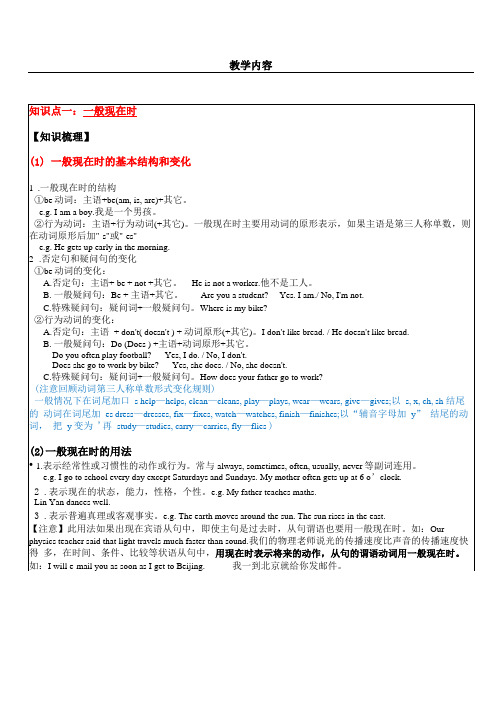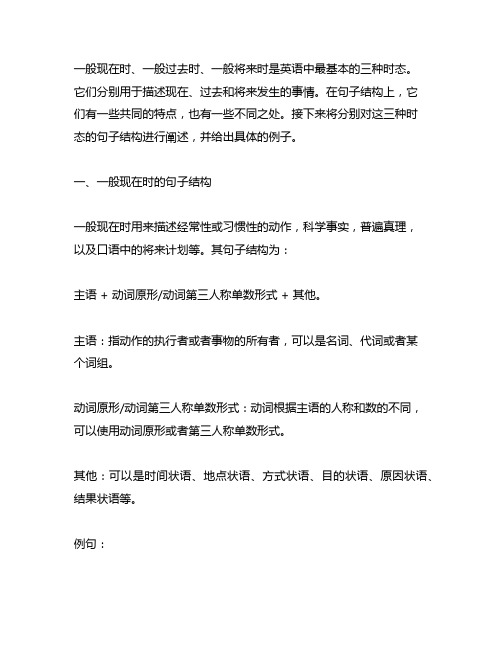一般现在时和一般过去时的区别
一般现在时、一般过去时、一般将来时

教学内容【例题精讲】例1.------ W ho is that lady?She's Miss Green. She us music, and she is so good.A. taughtB. teachesC. will teachD. is teaching 例 2. I think I'll take a bus to the meeting.A. do The bus? If you, you will be late.B. have doneC. will do例3. Unless the weather, we will have to cancel the picnic.A. improveB. improvesC. improvedD. will improve例4. We don't know if our friend .If he, we'll let you know.A. comes; comesB. comes; will come例5. Our geography teacher told us that the earth C. will come; comesthe sun.A. went aroundB. goes aroundC. is going aroundD. was going around【课堂练习】1.Look! A dog a blind man across the road.A. leadsB. leadC. is leadingD. led2.They usually TV in the evening.A. watchB. will watchC. are watchingD. watches3.He hardly up early.A. getsB. getC. doesn't getD. don't get4.John football.A. likes playingB. likes playC. like play5.Frank usually in touch with his primary school teachers by email.A. keepB. keepsC. keptD. will keep知识点二:一般过去时【知识梳理】(1)一般过去时的基本结构和变化1.定义:表示过去某时发生的动作或存在的状态。
一般现在时,现在进行时,一般过去时讲解

一般过去时态〔1〕根本用法1.一般过去时通常用来表示过去发生的动作或存在的状况。
如:--- Where were you last week"上周你在哪儿?--- I was at my uncle's home in the countryside.〔上周〕我在乡下的叔叔家。
2.有些情况,发生时间没有明确标明,但实际上是过去发生的,应用过去时态;另外,在谈到已故去的人时,也多用过去时。
如:He bought a cat, and now they are good friends.他买了一只猫,现在他们是好朋友了。
Lu *un was a great writer.鲁迅是一位伟大的作家。
〔2〕时间状语与一般过去时连用的时间状语有:yesterday〔昨天〕, last night〔昨晚〕, last week〔上个星期〕, four days ago〔四天前〕, in 2002〔在2002年〕, just now〔刚刚〕, the day before yesterday〔前天〕等。
如:He went to the park yesterday.她昨天去了花园。
I was ten years old in 2001.我2001年才10岁。
〔3〕动词的过去式在一般过去时态中会涉及到动词的过去式,大家要掌握规则动词的过去式的变化规则。
其根本的变化规则如下:①一般情况下,在动词原形后直接ed。
如:play –played , look –looked。
②以e结尾的动词在其后加d。
如:like –liked, use –used。
③与辅音字母加y结尾的动词,把y变成i再加ed。
如:carry – carried, marry - married。
④以重读闭音节〔或r音节〕结尾,末尾只有一个辅音字母时,双写这个辅音字母,再加ed。
如:stop –stopped, prefer –preferred。
一般现在时与一般过去式的比较

4)疑问词+can +主语+V原形+其他?
What can you sing ?
一般过去时:
1)疑问词+was/were 主语+其他? Where were you yesterday ? 2)疑问词+did+主语+V原形+其他? Where_____you_____(go) just now ? 3)疑问词+could +主语+V原形+其他? What could you do when you were 5 ?
二、否定句: 一般现在时: 1)主语+am/is/are not+其他 I am not a student. '2)主语+don't/doesn't +谓+宾+... I/You/They don't play soccer after school. He/She/Jim doesn't play soccer after school. 3)主语+can't+V原形+其他
五、关键词 一般现在时: often(经常)、usually(通常),sometimes(有时),always(总 是),seldom(很少,几乎没有),never(从来没有),Every day/week/month/year(每天/周/月/年),on Sunday(在星期天), once a week(一周一次),in the morning/afternoon/evening(在 早上/下午/晚上)等时间状语连用。
一般过去时: 1)表示过去的状态 I was happy yesterday. 2)表示过去时间里经常性/习惯性的动作。 She often watched TV after supper last year. 3)表示主语过去的性格/能力。 She could play the guitar when she was 10.
英语十六种时态和8种语态以及区别注意事项

目录16种时态 (1)1. 一般现在时 (2)2. 现在进行时(be doing) (3)3. 现在完成时(have done) (3)4. 现在完成进行时(have been doing) (4)5. 一般过去时 (4)6. 过去完成时(had done) (5)7. 过去将来时(would/ should do) (5)8. 过去进行时(was/ were doing) (5)9. 一般将来时 (6)10. 将来进行时(will be doing) (7)11. 将来完成时(will have done) (7)12将来完成进行时:shall have been doing ,will have been doing (7)13过去完成进行时:had been doing (8)14过去将来进行时:should be doing , would be doing (8)15 过去将来完成时:should have done , would have done (8)16 过去将来完成进行时:should have been doing , would have been doing (8)一、一般过去时与现在完成时的转换 (8)二、一般现在时与现在进行时的转换 (8)三、现在进行时与一般将来时的转换 (9)四、“be going to+动词原形”与“will(shall)+动词原形”结构的转换 (9)We shall visit the Great Wall next Sunday (9)时态区别 (9)一、现在完成时和一般过去时的区别 (9)二、现在完成进行时和一般进行时 (9)三、现在完成进行时和现在完成时 (10)四、过去进行时和过去时的区别 (11)8种被动语态的构成 (12)(一)语态的基本概念和种类 (12)(二)被动语态的构成 (13)(三)被动语态的用法 (13)(四)主动语态变被动语态的方法与注意事项 (13)(五)不用被动语态的情况 (14)(六)复习时需要注意的要点 (14)附:英语语法术语的英文表达 (15)时态(Tense)是表示行为、动作和状态在各种时间条件下的动词形式。
一般现在时一般过去时一般将来时的句子结构

一般现在时、一般过去时、一般将来时是英语中最基本的三种时态。
它们分别用于描述现在、过去和将来发生的事情。
在句子结构上,它们有一些共同的特点,也有一些不同之处。
接下来将分别对这三种时态的句子结构进行阐述,并给出具体的例子。
一、一般现在时的句子结构一般现在时用来描述经常性或习惯性的动作,科学事实,普遍真理,以及口语中的将来计划等。
其句子结构为:主语 + 动词原形/动词第三人称单数形式 + 其他。
主语:指动作的执行者或者事物的所有者,可以是名词、代词或者某个词组。
动词原形/动词第三人称单数形式:动词根据主语的人称和数的不同,可以使用动词原形或者第三人称单数形式。
其他:可以是时间状语、地点状语、方式状语、目的状语、原因状语、结果状语等。
例句:1. I study English every day.(我每天学英语。
)2. He speaks Chinese fluently.(他讲中文流利。
)3. The sun rises in the east.(太阳从东方升起。
)二、一般过去时的句子结构一般过去时用来描述过去发生的事情或者已经完成的动作。
其句子结构为:主语 + 动词过去式 + 其他。
例句:1. I finished my homework yesterday.(我昨天完成了我的作业。
)2. She bought a new car last week.(她上周买了一辆新车。
)3. They visited the museum two days ago.(他们两天前参观了博物馆。
)三、一般将来时的句子结构一般将来时用来表示将来发生的动作或者情况。
其句子结构为:主语 + will/shall + 动词原形 + 其他。
例句:1. I will go to the cinema tomorrow.(我明天将去电影院。
)2. She shall help you with your project next week.(她下周将帮助你完成项目。
一般过去时和一般现在时的知识梳理

一般过去时和一般现在时的知识梳理一般过去时和一般现在时是英语中最基本的两种时态,它们用来描述不同的时间状态。
下面将分别对这两种时态进行详细的梳理。
一、一般过去时1. 一般过去时的基本用法一般过去时用来描述过去某个时间发生的动作或存在的状态,通常和表示过去的时间状语连用,如yesterday(昨天)、last week (上周)、two years ago(两年前)等。
例如:- I went to the park yesterday.(我昨天去了公园。
)- They studied English last night.(他们昨晚学习了英语。
)2. 一般过去时的构成一般过去时的肯定句结构为“主语+ 动词过去式+ 其他”,否定句结构为“主语+ did not + 动词原形+ 其他”,疑问句结构为“Did + 主语 + 动词原形 + 其他”。
例如:- He played basketball with his friends.(他和朋友们打篮球。
)- They did not watch the movie.(他们没有看那部电影。
)- Did you visit your grandparents last weekend?(你上周末去看望你的祖父母了吗?)3. 一般过去时的时间状语一般过去时常常和表示过去的时间状语连用,如yesterday(昨天)、last month(上个月)、in 1999(在1999年)等。
时间状语可以出现在句首、句中或句末。
例如:- Last night, I watched a movie.(昨晚,我看了一部电影。
)- He lived in New York for five years.(他在纽约住了五年。
)二、一般现在时1. 一般现在时的基本用法一般现在时用来描述当前的状态、习惯或经常发生的动作。
它表示的是客观事实或普遍真理,与时间无关。
例如:- The sun rises in the east.(太阳从东方升起。
一般过去时一般现在时一般进行时知识点
一般过去时一般现在时一般进行时知识点一、知识概述《一般过去时、一般现在时、现在进行时知识点》①基本定义:- 一般过去时:简单来说,就是用来描述过去发生的事情。
比如昨天发生的、上个星期或者以前某个时候的动作或状态。
例句:I played football yesterday.(我昨天踢足球了。
)- 一般现在时:这是用来表示经常发生的事情或者客观事实等。
像每天都做的事,太阳从东边升起这种不会变的事实。
例如:He gets up at 7 o'clock every day.(他每天7点起床。
)- 现在进行时:表示现在正在进行的动作。
就像此刻正在做的事。
比如说:She is reading a book now.(她现在正在读一本书。
)②重要程度:- 在英语学科中相当重要,是最基础的时态部分。
如果时态学不好,就像盖房子没有打好地基,以后学习更复杂的语法就会特别难。
不管是口语交流还是书面表达,正确使用时态才能准确传达想要表达的意思。
③前置知识:- 要知道一些基本的动词及其变形,还有主语的单复数概念。
例如,动词在第三人称单数(当主语是he/she/it等时)一般现在时中的变化等基础概念。
④应用价值:- 在日常生活中很有用。
当你讲过去做了啥,经常做啥和现在正在做啥的时候,就离不开这几个时态。
比如和朋友聊天,介绍自己的日常习惯(一般现在时)、正在做的事情(现在进行时)或者讲以前的经历(一般过去时)。
二、知识体系①知识图谱:- 在英语语法体系里,时态这块儿它们就像基础的砖块。
一般过去时、一般现在时和现在进行时是初步接触时态学的时候的重点部分,后面再学其他时态,像是过去进行时、现在完成时等都会和这几个时态有联系。
②关联知识:- 与词性、句子结构是有联系的。
比如说动词在不同时态下的变化就和动词的词性有很大关系。
同时在复杂句子结构中要正确选择合适的时态才能保证整个句子表达合理。
③重难点分析:- 掌握难度方面,对初学者来说,可能一般现在时在第三人称单数后面动词的变化比较难记,像go变成goes这种。
(完整版)一般现在时一般过去时现在进行时过去进行时归纳总结
(完整版)一般现在时一般过去时现在进行时过去进行时归纳总结一般现在时一般过去时现在进行时过去进行时1. 一般现在时(1)一般现在时的构成动词一般用原形,若主语为单数第三人称,则动词加词尾-s或-es,具体变化规则如下(与名词的单数变复数规则大致一样):1.一般情况下由动词后加-s构成。
如:work→works 工作read→reads 读look→looks 看come→comes 来live→lives 居住listen→listens 听2.以s, x, z, sh, ch 以及字母o结构的动词,后加-es。
如:guess→guesses 猜mix→mixes 混和go→goes 去finish→finishes 完成catch→catches 抓住3.以辅音字母加y结尾的动词,应将y改为i 再加-es。
如:fly→flies 飞行study→studies 学习carry→carries 带,扛一般现在时主要用动词的原形表示,如果主语是第三人称单数,则在动词原形式后加—s 或—es 。
如:Tom often helps his parents do housework at home.汤姆在家经常邦助父母做家务。
Sometimes Lucy washes her clothes herself.有时候露西亲自洗她的衣服。
(2)一般现在时的用法1)表示经常性或习惯性的动作或存在的状态。
与often , always ,usually , sometimes , once a week , every day 等表示频度的副词或时间状词连用。
如:I often go to school by bike. 我经常骑自行车去上学。
2) 表示客观事实或普遍真理。
如:The earth goes around the sun .地球绕着太阳转。
3)在时间、条件等状语从句中,用现在时表示将来。
如:If it rains tomorrow, we won’t go to the park.如果明天下雨,我们就不去公园了。
一般现在时、现在进行时、一般将来时、一般过去时四大时态讲解表格对比总结
四大时态总结--------一般现在时、一般将来时、一般过去时、现在进行时一、一般现在时一般现在时表示经常性或习惯性的动作,常与表示频度的时间状语连用,如often, usually, always, sometimes, never, seldom, every week/day/year/month..., once a week, on Sundays等。
动词用原形。
当主语第三人称单数的动词变化规则:(只有在第三人称(he, she, it, 一个人名)为主语的肯定句中,动词才用三单式)(1)一般情况下,直接加sruns gets likes(2)结尾是s, x, sh, ch, o,前为辅音字母,结尾加es watches, goes, washes, crosses, mixes, does(3)动词末尾y,前为辅音,将y改为i加esstudy→studies fly→flies但在y前如果为元音则直接加s buys says plays(4)不规则变形have—has二、现在进行时现在进行时表示此时此刻或现阶段正在进行的动作。
常与now, at this time, these days, Listen! Look! at this动词加ing规则(1)直接在动词后加ing.going, starting, working.(2)去掉词尾不发音的e,再加ing. leave--leaving, make---making.注意:如果单词结尾的e发音,则不能去掉,也直接加ing. see –seeingagree - agreeing .(3) 对于动词只有一个元音,而其后跟了一个辅音字母时,双写末尾辅音字母再加ing.sitting, beginningrun – runningstop – stoppingcut – cuttingcontrol – controlling(4)以ie结尾,把ie变y再加ing。
一般现在时、一般过去时和被动语态
I .The Simple Present and Past Tense II .The passiveI. 一般现在时和一般过去时1、一般现在时表示经常性的动作、现在存在的情况或状态和一般真理,也可用来描述工作过程等一系列连续动作。
如:The factory produces cars .这个工厂生产汽车。
The earth goes round the sun .地球绕太阳运行。
Scientists go down into the sea ,collect sea plants ,study them and then writ e papers .科学家下潜入海,采集海生植物,研究所采植物,然后写出论文。
2、一般过去是表示过去发生的动作或存在的状态,常和表示过去时间的状语连用。
如:yesterday ,last year ,three days ago 等。
This factory produced 600 cars last month.Exercise 1. Cross out the wrong words in the brackets.1.The computer (gives, gave)us lesson in the correct usage of English words and phrase once aweek .2.The computer (gives, gave)us lesson in the correct usage of English words and phraseyesterday .3.In 1969 ,a rocket (takes ,took)men to the moon for the first time.4.Rockets (are ,were)usually very big.5.The worker (cleans ,cleaned)the machines every day.6.The worker (cleans ,cleaned)the machines last week .Exercise bine the left with the right ,making as many sensible sentences as possible.1. A rocket reached the moon every dayWe built a big rocket not long ago2.The students do their mathematics in 1969with a computer4. We have English lessons once every two yearsII. The passive 被动语态英语动词又主动语态和被动语态之分,以表示主语和谓语之间的不同关系。
- 1、下载文档前请自行甄别文档内容的完整性,平台不提供额外的编辑、内容补充、找答案等附加服务。
- 2、"仅部分预览"的文档,不可在线预览部分如存在完整性等问题,可反馈申请退款(可完整预览的文档不适用该条件!)。
- 3、如文档侵犯您的权益,请联系客服反馈,我们会尽快为您处理(人工客服工作时间:9:00-18:30)。
- . z. 一般现在时和一般过去时
1.满招损,谦受益.Pride hurts, modesty benefits 2.世上唯有贫穷可以不劳而获.Nothing is to be got without pain but poverty. 3.伟业非一日之功/冰冻三尺非一日之寒.Rome was not built in a day. 一般现在时 一、 定义与讲解 一般现在时:表示经常性的事情,经常性的动作或一般性事实。 时间状语:often 经常,usually通常,always 总是,every每个,sometimes 有时,at …在几点钟 只有在第三人称单数用动词的“三单变化〞,其他用动词的原形。 三单变化: 1.多数在动词后+s play — plays like — likes 〔1〕直接在动词词尾加-s. ask---asks;work---works;get---gets;stay---stays 〔2〕以字母s, *, ch, sh或o结尾的动词,在词尾直接加-es. watch---watches;wish---wishes;fi*---fi*es; do---does; go---goes; pass---passes 〔3〕以“辅音字母加 - y〞结尾的动词,要先变y为i再加-es. try---tries study---studies cry---cries fly---flies
情况 构成方法 读音 例词
一般情况 加 -s 清辅音后读/s/ 浊辅音和元音后读/z/
swim-swims;help-helps;
like-likes
以辅音字母+o结尾的词 加 -es 读/z/ goes,does
以s,sh,ch,*等结尾的词 加 -es 读/iz/ watches,washes 以辅音字母+y结尾的词 变y 为i再加es 读/z/ study-studies
不规则变化have和be动词 变have 为 has变be为am,is,are have-has be-am,is,are
2.不规则变化: be---- is are have----has 二、一般现在时的用法 1、一般现在时表示经常性或习惯性的动作,常与表示频度的时间状语every day, usually, always, often, sometimes, on Sunday等连用。 如:I ___________ at 6 every morning. 每天早上我七点去上学。 - . z. 2、一般现在时表示客观存在及普遍真理。 如:Summer______〔follow〕 spring. 春天之后是夏天。 The sun ____(rise) in the east. 太阳从东方升起。 The earth_____ (move)around the sun . 注意:此种用法即使出现在过去的语境中,仍用一般现在时。 如:I learned that the earth goes around the sun when I was in primary school. 我在小学就学过地球是围绕太阳转的。 3、一般现在时表示格言或警句。 如:Pride goes before a fall. 骄者必败。 4、以here, there等开场的倒装句,表示动作正在进展。 如:Here es the bus. = The bus is ing. 车来了。 There goes the bell. = The bell is ringing. 铃响了。 5、在以下情况下表示将来: 1〕在状语从句中用一般现在时代替一般将来时。 如:I will give it to him as soon as I see him. 我一看见他就交给他。 He will e if you invite him. 如果你请他,他会来的。 Suppose he doesn’t agree,what shall we do"假设他不同意,那怎么办" I shall do as I please. 我快乐怎么做就怎么做。 He will continue the work no matter what happens. 不管发生什么情况他都要继续这项工作。 批注:可结合主将从现进展讲解 2〕在the more…the more …(越……越……) 句型中,前者通常用一般现在时代替一般将来时,因为前者相当于条件状语从句。 如:The harder you study, the better results you will get. 你学习越努力,成绩就会越好。 3〕在make sure (certain), mind, care, matter后的宾语从句的谓语动词用一般现在时代替一般将来时。 如:Make sure that you are not late again. 注意别再迟到了。 4〕表示按方案或时间表将要发生的动作,通常有表示将来的时间状语。 如:The plane takes off at 11:30 and arrives in Shanghai at l:20. 飞机十一点半起飞,一点二十分抵达**。 批注:只限于少数动词能这样用,如 begin, start, end, finish, stop, go, e, leave, sail, arrive, return, close, open等。 一般过去时 一、一般过去时的定义 表示过去*一时刻或*一时间段内发生的动作或存在的状态,过去时间标志词: 〔1〕yesterday系列: yesterday, yesterday morning ,yesterday afternoon ,yesterday evening, the day before yesterday 〔2〕last系列: last week, last month, last year, last night 〔3〕ago系列: two months ago, three years ago 〔4〕in系列: in 1990, in 2012 - . z. 特殊:just now ,in the past等等。 e.g: I was born in 1990. When did you go to the park" I went to the park last week. 二、一般过去时的用法 1. 动词过去式的构成规律 1〕.一般在动词末尾加-ed,如:pull-pulled, cook-cooked 2〕.结尾是e加d,如:taste-tasted 3〕.末尾只有一个元音字母和一个辅音字母的重读闭音节,应双写末尾的辅音字母,再加-ed,如:stop-stopped 4〕.以“辅音字母+y〞结尾的,变y为i, 再加-ed,如:study-studied 5〕 .不规则动词过去式: am,is-was, are-were, do-did, see-saw, say-said, give-gave, get-got, go-went, e-came, have-had, eat-ate, take-took, run-ran, sing-sang, put-put, make-made, read-read, write-wrote, draw-drew, drink-drank, fly-flew, ride-rode, speak-spoke, sweep-swept, swim-swam, sit-sat 过去时练习:写出以下动词的过去式 is\am_________ fly_______ plant________ are ________ drink_________ play_______ go________ make ________ does_________ dance________ worry________ ask _____ taste_________ eat__________ draw________ put ______ throw________ kick_________ pass_______ do ________ 加“-ed〞后的读音方法 1.ed加在清辅音后面读/t/。 finished /-t/ help /-t/ asked /-t/ 2.ed加在浊辅音或元音结尾的,读/d/。 played /-d/ lived /-d/ enjoyed /-d/ 3.ed加在/t/或/d/后面,读/id/。 wanted /-tid/ needed /-did/ visited /-tid/ 批注:对于不规则动词变化,可以选择孩子会初一或小学已经接触到的不规则动词变化,不要都讲。读音规律,对于掌握好的同学可以拓展。 2. 句式变化 三、一般过去时中应注意的问题 1. 判定是一般过去时后,谓语动词一定要用过去式。 课堂测试 1.I _______〔be) at school just now. 2. I ______ (watch) a cartoon on Saturday. 3. We _________ to zoo yesterday, we _____ to the park. (go) 4. ______ he _______ (fly) a kite on Sunday" Yes, he ______. 5. He ________ (be) at the camp last week. 批注:根据孩子的实际掌握情况,选择题量。 2. 句式变化中,动词过去时不要忘记复原原形。 课堂练习 1. Su Hai took some photos on Sports day. 否认句________________________________________________ 一般疑问句:____________________________________________ 肯、否认答复:__________________________________________
